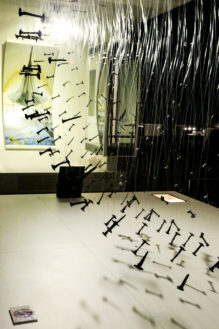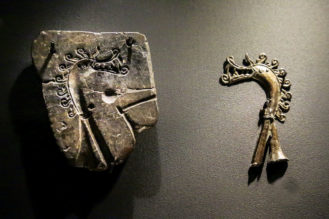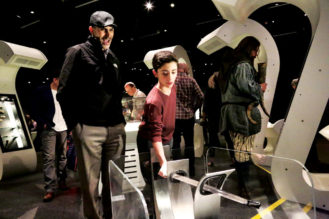
‘Gudmund the Red,’ a trader, travels the world to trade his wool, wood, honey and fur for silver, glass and jewels. His scales reflect the value he places on certain items, like the ring he procured in the Middle East. Placing a heavy weight on the scales, he says, ‘This ring is worth a lot to me, so you must give me this much weight in silver for it.’
Vikings from Steve Larson on Vimeo.
The thought of Vikings conjures visions of bearded barbarians pillaging their way across Europe in horned helmets. But this stereotype is only partly true, as demonstrated in Vikings: Beyond the Legend, at the Denver Museum of Nature & Science through Aug. 13.

An ax and a sword are among the crafts and tools on display. Display cases show the ‘workbench’ of tools used to craft a product, the raw materials used, and the finished product. Axes were more common than swords, so axes were often used in battle.

A ‘ghost ship’ represented by a sculpture of 219 hanging iron rivets from an authentic aristocratic burial ship. All the wood from the boat disintegrated, leaving only the rivets situated in the ground in the positions shown in the sculpture.
“The Vikings were skilled craftspeople, merchants and farmers,” said Samantha Sands, museum educator. “Their ingenuity showed in their tools and crafts, including textiles and metalwork. They were particularly adept at shipbuilding, which is why they could sail great distances—as far from their homes as the Middle East and Newfoundland off of North America.”
The word “Vikings” itself is misunderstood. Viking is not a nationality. Between 750 and 1100 CE, the area now known as Denmark, Norway and Sweden—Scandinavia—was inhabited by a mix of societies that had much in common but were not unified under one governing system. They used the term “viking” to describe a trade expedition or a raid but did not use the word to describe themselves as a people. Over time, archaeologists and historians have come to refer to them as Vikings.

Swedish dress pin, made with reference to the casting mould at left. Dress pins of this kind were usually molded out of silver or gold. Skilled craftspeople creatively used textiles, wood, metal, bone, leather, glass, and ceramics to create pieces for domestic life, ornamentation, and battle.
“It’s true the Vikings were known for their brutality and pillaging, but they also used their swift, sturdy ships to establish trade with far-flung areas, and they preserved artifacts from other countries,” said Swedish Ambassador Björn Lyrvall, who visited Denver for the exhibition’s opening. Most of the nearly 500 items on display are from the Swedish History Museum.
The exhibition includes several reproductions of these “swift, sturdy ships,” including the Eik Sande, a 120-foot-long ship built before 895, complete with an authentic woven wool sail. To re-create the ship, modern craftsmen used Viking-era tools, three-foot-wide oak planks and tallow, as well as handmade rigging rope.

Charles Bresler, 12, who attends DSST: Stapleton, lifts a sword to guess its weight: 6 or 7 pounds, he estimates.
Amid the authentic clothing, ornaments and weapons, visitors will NOT see horned helmets. “Artifacts show no evidence of horns,” said Sands. “The horns came about in the late 1800s, when a villain in one of Wagner’s Ring Cycle operas wore a horned helmet.”
The museum’s historical enactors set the stage and bring the Viking Age to life. Ingibjorg, a Viking wife, weaves as she tells visitors that her first husband went out on a “viking” and did not return, so she married his brother, a farmer. “In Viking societies, women held the keys to the family’s valuables and inheritances came through both men and women,” said Sands. “Often a widow married her husband’s brother to keep the land in the same family.”
Denver’s Museum of Nature & Science is open from 9am–5pm every day at 2001 Colorado Blvd. For more information and tickets, see www.dmns.org or call 303.370.6000.




0 Comments